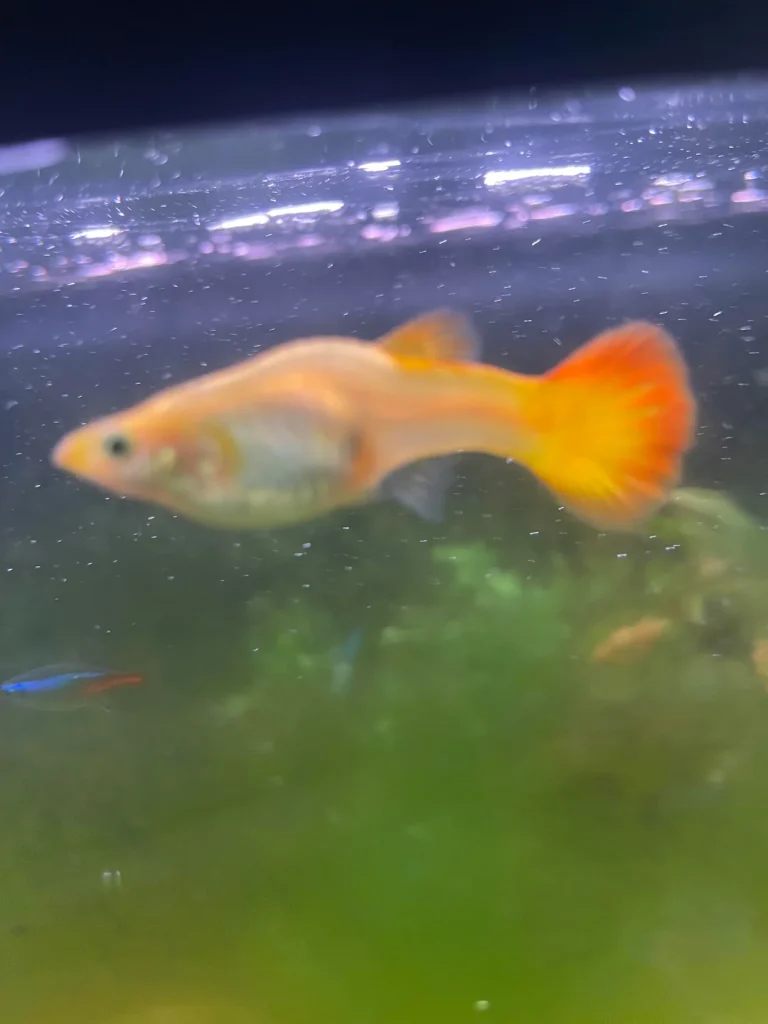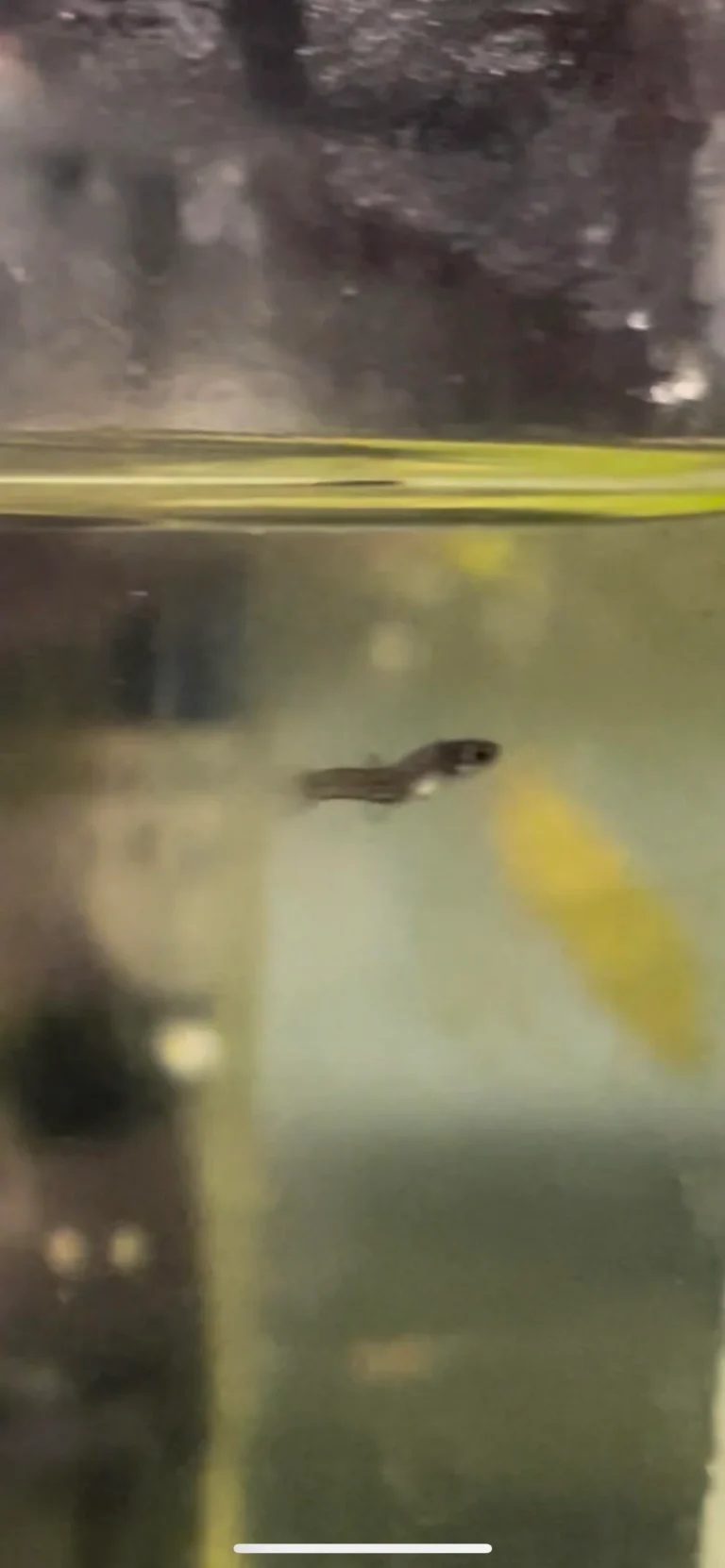Did You Give Guppy Bent Spine?
Is It Serious And Long Does It Have Left?
You may have had your guppies for a while now or maybe you just had a successful breeding and now are caring for a bunch of fry.
But one day you noticed one of your guppies has a bent spine.
Well, why does your guppy have a bent spine?
Let’s dive in.
TL;DR Version
Guppy Bent Spine
A bent spine in guppies isn’t dangerous or harmful- it’s simply a genetic defect that gives guppies a curved look to their spine.
The main reason it happens is inbreeding. The bent spine can appear pretty early in life, but it is not uncommon for it to develop well into a guppy’s adulthood. It is not something you caused and isn’t tied to water conditions, diet, or anything in your control.
It has little to no effect on the individual fish itself- unless the spine is so bent that it makes it difficult to swim.

What Is Guppy Scoliosis
Guppy Bent Spine, also known as Scoliosis, is a condition where your guppy’s spine looks bent or curved.
This condition can occur naturally but is usually the result of inbreeding. It is fairly common when you buy fish from commercial places that your guppy may develop it later in life.
Guppies with bent spines exhibit a noticeable curvature of the backbone, resulting in a bent or twisted appearance. How bad the curve is can vary from mild to severe, and it can affect different segments of the spine.
When Does It Happen?
Guppy scoliosis, or Bent Spine, can occur at various stages of a guppy’s life, and its development can be influenced by both genetic and environmental factors.
Here are the key stages when you are able to spot guppy scoliosis:
Early Development
Genetic factors play a significant role in the development of scoliosis in guppies.
Some guppy strains, like Moscow or Veiltail, are more prone to developing scoliosis due to selective breeding for certain physical traits. Usually, it’s the “fancy” breeds tend to be more predisposed to a bent spine.
Notice that the magic words here are “tend to be” and “more predisposed”
What I’m essentially hiding in this word salad is that it is only sometimes, but not all. If you get one of these breeds, it doesn’t necessarily mean your guppy will have a bent back.
If the parents carry genetic predispositions for scoliosis, their offspring have a higher chance of inheriting the condition
Juvenile Stage
The condition can become more apparent during the juvenile stage of guppies’ lives.
Remember that with time the bent spine will become more and more pronounced.
As your guppies grow and their bodies undergo rapid development their bent or curved spine will become more and more apparent.
Guppies go from fry to adult in as little as 12 weeks, which at any point either underlying genetic predispositions or environmental stressors can lead to a bent spine.
Older Years
As guppies begin to age some of those traits can come to light.
You may notice that someday your guppy suddenly has a curved spine. And hey, it actually can continue to curve with time.
Guppies only live between 2-3 years, and this may be a sign that your guppies are getting older.
Is A Bent Spine Dangerous To A Guppy
Sort of , but not really.
Guppy bent spine is primarily a cosmetic issue and does not usually cause significant health problems or pain for the fish.
With that being said, severe cases of scoliosis can impair the fish’s swimming ability.
That will affect overall mobility, making them more vulnerable to predation and reducing their quality of life.
How To Identify Guppy Bent Spine
To identify the signs of a bent spine in guppies you’d need to take a closer look at them.
Here are some signs to look for when identifying guppy scoliosis:
Bent or Curved Spine
The most noticeable sign of guppy scoliosis is a bent or curved spine.
Look closely at the fish from above or from the side to see if their spine appears abnormally curved or twisted.
The curvature can range from mild to severe and may affect different segments of the spine.
Crooked or Misaligned Tail
In addition to the curvature of the spine, guppies with scoliosis may have a crooked or misaligned tail.
The tail may deviate to one side or show irregular angles instead of a straight alignment.
Uneven Body Shape
Scoliosis can cause the guppy’s body to appear asymmetrical or uneven.
look at your fish from the side. Does one side of the fish look larger or more pronounced compared to the other side?
Difficulty Swimming
Severe cases of scoliosis can affect the guppy’s swimming ability.
They may exhibit abnormal movements, struggle to swim straight, or have difficulty maintaining balance in the water.
You’ll be able to see that your guppy is swimming very awkwardly because of it.
Abnormal Behavior
Guppies with scoliosis may display signs of discomfort or reduced activity levels.
They may show a lack of appetite, appear lethargic, or exhibit unusual behaviors compared to healthy guppies.
Always pay attention to any animal’s behavioral change. It is almost always trying to tell you something when behavior changes.
Why Does My Guppy Have A Bent Spine
Ok, so by now you already know what guppy scoliosis is and what it looks like.
But what causes it? and are there any ways to prevent it?
Genetic Predisposition
Genetic factors play a significant role in the development of scoliosis in guppies.
Some guppy strains have a higher incidence of scoliosis due to selective breeding for specific physical characteristics.
These strains are often referred to as “show strains” or “fancy strains.”
It is important to note that not all individuals within these strains will develop scoliosis, but the genetic predisposition for the condition is more prevalent.
These breeders include Moscow, dragon and veiltail.
Inbreeding and genetic mutations can increase the likelihood of scoliosis in offspring.
Poor Breeding Practices
Unregulated or irresponsible breeding practices can contribute to the prevalence of scoliosis in guppies.
We’ve gotten into it in detail when we covered how to breed guppies.
Don’t breed fish that already show signs of scoliosis or carry genetic predispositions for the condition can pass it on to their offspring.
Nutritional Deficiencies
Feeding your guppy during the critical stages of growth and development can impact the skeletal development of guppies.
A lack of essential nutrients, such as calcium and vitamin D, can lead to weakened bones and increased susceptibility to skeletal deformities like scoliosis.
Your guppies should be getting those from their fish food, but sometimes may need a little extra.
You can give them a boost calcium by feeding them crushed eggshells (thoroughly cleaned and baked to remove any contaminants).
You can also feed them blanched or boiled spinach leaves, and small amounts of finely crushed cuttlebone (a hard internal structure of cuttlefish).
Other options include finely chopped portions of vegetables like kale, broccoli, and collard greens.
These should be blanched or steamed to make them easier for the guppies to consume and digest.
My Guppy Has A Bent Spine. Now What?
Well, nothing. Unless your guppy is unable to swim, they’re just going to have a bent spine.
It is worth noting that Bent Spine is generally a hereditary condition.
That means that affected fish should not be used for breeding to prevent passing on the genetic predisposition to offspring.
If you notice signs of Bent Spine in your guppies, it is advisable to consult with a veterinarian or a knowledgeable aquatic professional for further guidance and to rule out other underlying health issues.


